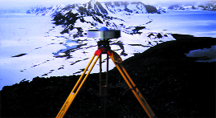 In southern
Alaska, melting glaciers heat up the possibility of earthquakes. That’s
according to new research linking ice mass changes caused by glacial thinning
to an increase in local seismicity and the occurrence of past earthquakes.
In southern
Alaska, melting glaciers heat up the possibility of earthquakes. That’s
according to new research linking ice mass changes caused by glacial thinning
to an increase in local seismicity and the occurrence of past earthquakes.A GPS station, measuring surface deformation, stands watch over the Bagley Ice Field in southern Alaska. As glaciers move across the landscape, their immense weight warps Earth’s crust and can delay or hasten earthquakes. Image courtesy of Jeanne Sauber.
In the July Global and Planetary Change, Jeanne Sauber, a geophysicist at NASA’s Goddard Space Flight Center in Greenbelt, Md., and Bruce Molnia, a geologist with the U.S. Geological Survey in Reston, Va., report that in the past 80 years, the wastage of coastal glaciers in the Icy Bay and Malaspina regions of Alaska is so great that it has reduced the stability of faults in the region and may have hastened the magnitude-7.2 St. Elias quake in 1979.
“I’ve learned that if you are going to be doing earthquake hazard assessments in places like southern Alaska,” Sauber says, “you need to include the history of what glaciers are doing.” Along the southern coast of Alaska, the Pacific plate subducts beneath the North American plate at a rate of roughly 50 millimeters per year. The resulting strain in the crust accumulates until an earthquake releases the pent-up energy. When large glaciers or ice sheets move across the landscape, their immense weight actually depresses Earth’s crust. When glaciers retreat, the ground rebounds back into place. In tectonically active areas experiencing glacial retreat and postglacial rebound, “earthquakes may occur sooner” than if they were still covered by glaciers, Sauber says.
Erik Ivins, a geophysicist at NASA’s Jet Propulsion Laboratory in Pasadena, Calif., says that earthquakes that occur in places previously covered by glaciers may be larger than normal “because the ice mass overburden was keeping smaller earthquakes from releasing tectonic stress.” In contrast, when little or no ice is present, he says, the glaciers “don’t push down on the earth as much, and fractures can form because they are under less pressure.” Movement along smaller fractures keeps the strain that precedes larger earthquakes from building up in the crust.
The relationship between earthquakes and glaciers in tectonically quiescent areas supports the research, says Thomas James, a geophysicist with Natural Resources Canada in British Columbia. In Scandinavia and Canada, large earthquakes associated with glacial retreat and post-glacial rebound occurred at the end of the Pleistocene ice age, he says.
In those instances, it is clear that postglacial rebound was responsible for the earthquakes, Sauber says, but, in southern Alaska, “tectonics are more important.” Glacial fluctuations only influence the timing of earthquakes, she says.
Sauber, who first went to Alaska to study tectonics, noticed that the movement of glaciers affected GPS measurements of surface deformation. Trying to sort out the influence of glaciers led to the new study. “What was at first a nuisance turned into a whole new line of research,” she says. She says she hopes that glacier fluctuations will be included in future paleoseismic studies used for earthquake hazard assessments. “This is one of the challenges of understanding seismic hazards,” James says, “sorting out the effect of past glaciations from background deformation.”
Future research will concentrate on constraining ice thickness changes using NASA’s ICESat satellite, Sauber says. Changes in ice thickness will help determine which areas are most likely to experience earthquakes associated with glacial melting.
The new research may also have implications outside of glaciated areas. “This may cause some people to worry about land-use decisions,” Ivins says. “For example, when you decide to move water from a reservoir or to drain a reservoir, you increase the chances of inducing earthquakes,” he says. “But you have to take it all with a big grain of salt — this is all in the nebulous field of earthquake prediction.”

